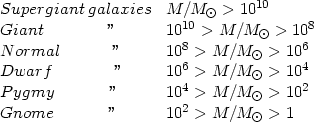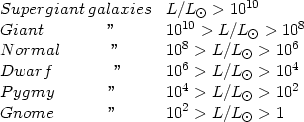


4. Galaxies
In order to achieve a fruitful meeting of the minds among astronomers who, at the present time seem to be highly confused on the subject of galaxies, we propose first to formulate operationally useful definitions of the cosmic objects which we are going to discuss, to be followed by a short history of the discovery of compact galaxies.
Definition of what a galaxy is.
Two possibilities come to mind. In the first place we might attempt to state what galaxies are composed of and thus arrive at a definition similar to those given for molecules or rocks, for instance. On the other hand we must not necessarily go into any details regarding the composition of the objects in question, which actually we would be quite unable to do at the present time. I therefore propose to define various classes of galaxies simply in terms of their absolute luminosities or their masses, quite regardless of what types of matter and of radiation they might be composed of.
In parenthesis it is useful to recall that, before the sixteenth century, astronomers did not know that the Milky Way is mostly composed of stars. Thus the name "Galaxy" for the Milky Way system, as derived from the Greek word "galactos," meaning milk. Incorrectly, astronomers continued to speak of the Milky Way system as the Galaxy even after it was recognized that it consists mostly of stars. Likewise, the extragalactic nebulae are called galaxies, although those known until recently mostly consist of stars.
During the past few years compact and very luminous extragalactic systems have been discovered, which may not contain any conventional stars at all but probably are composed of more or less hot gases with neutron stars and objects HADES imbedded in them. Paradoxically, some astronomers appear to hesitate calling these new objects galaxies, although that designation, in view of the meaning of the word "galactos" would be far more appropriate than to call stellar systems galaxies.
In view of the present uncertainty concerning the material contents of the various extragalactic systems. I propose to define and to classify them simply by conveniently chosen ranges of mass and absolute luminosity, as shown in the schemes (11) and (12).
Classification of cosmic objects according to mass:
 |
(11) |
Classification according to absolute photographic, visual or bolometric luminosity L:
 |
(12) |
We emphasize again that galaxies of the same class, as defined by (11) or (12), may of course be very different from one another, both as to their structures and their material and radiative contents. Some of the most striking differences in their structures are the nuclei, central cores and discs, knots, spiral arms, halos, jets, plumes and so on. In extreme cases of compactness all of the mass or luminosity may be concentrated in a small core (compact galaxies) or there may be no core at all, the galaxy simply consisting of a more or less irregular body of matter and of radiation.
Compact galaxies
Galaxies during the past two hundred years have been listed in increasing numbers in various catalogues, the newest one being the six volumes compiled by Zwicky and his collaborators (24). Until recently the NGC and IC catalogues, containing about 13,000 objects were the most widely used. The objects contained in the NGC and IC were generally thought to cover all types of possible galaxies. It does not seem to have occurred to any astronomers observing and analyzing objects listed in these catalogues that none among them show any average surface brightness, photographically or visually, greater than that corresponding to the twentieth magnitude per square second of arc. After discovering galaxies of very much greater average surface luminosity I proposed (7), in keeping with these findings, to call compact any galaxy as a whole, or any part of a galaxy, whose surface brightness, photographically, visually or bolometric ally is greater than that which corresponds to the 20th magnitude per square second of arc in any chosen wavelength range.
Compact galaxies
 |
(13) |
Among the well known nearby galaxies, Messier 32, the companion of the great
nebula in Andromeda, Messier 31, has an average surface brightness

 20.5/arcsec2
and therefore does not quite rate as a compact galaxy. Some astronomers
mistakenly believe that if M32 were put at a much greater distance it
would appear as a compact
galaxy. Actually this may be the reason why compact galaxies were not
discovered long ago. Obviously many observers must have seen them on their
photographic plates,
but apparently thought that they were just ordinary run of the mill
objects like M32, located at a great distance.
20.5/arcsec2
and therefore does not quite rate as a compact galaxy. Some astronomers
mistakenly believe that if M32 were put at a much greater distance it
would appear as a compact
galaxy. Actually this may be the reason why compact galaxies were not
discovered long ago. Obviously many observers must have seen them on their
photographic plates,
but apparently thought that they were just ordinary run of the mill
objects like M32, located at a great distance.